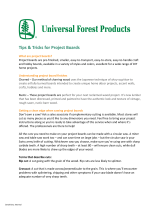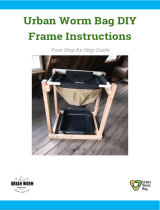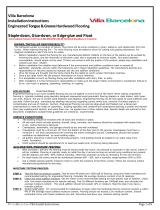
Tips & Tricks for Project Wood
Project Wood comes in smaller, easy-to-transport, easy-to-store, easy-to-handle panels in a
variety of thicknesses. The noted nominal thickness may not be the exact actual dimension – as
is common with dimensional lumber as well – but it will be close, and certainly close enough to
ensure you’re choosing the proper thickness for the requirements of your project. However,
“eyeballing” the thickness you’re looking for is the quickest and surest way to make your very
first mistake.
As they say, measure twice, cut once.
Understanding Plywood Grades
Veneer Grades: The best way to think of veneer grades is as school grades, with A being the
best/most desirable and D having the least favorable appearance.
A Grade – Sanded, smooth, paintable surface without knots. Any defects were small enough to
be neatly repaired by the manufacturer using a synthetic filler. This product is ideal for
furniture, cabinets, doors or any projects where beauty is of the utmost importance.
B Grade – Sanded, smooth, paintable surface. Veneers may have only a few small knots or
slight discoloration.
C Grade – Unsanded with observable minor defects that would need to be repaired if a more
attractive appearance is important. Knotholes may be up to 1½ inches across.
D Grade – Unsanded and potentially discolored with more significant defects and knotholes up
to 2½ inches across. This grade is often used for structural purposes or as sheathing that will be
covered with other products such as flooring, siding, roofing, etc.
Cutting Plywood
Don’t own a saw? Ask a sales associate if complementary cutting is available. Most stores will
cut as many pieces as you’d like to any dimensions you need. Feel free to bring your project
instructions along so you’re ready to take advantage of this service when and where it’s
offered. The professionals are there to help!
Getting a Clean Edge
All the cuts you need to make on plywood can be made with a circular saw. A miter saw and
table saw work too – and can save time on large jobs – but the circular saw is your Swiss army
knife of cutting. Whichever saw you choose, make sure you’re using one with sharp carbide

teeth. A high number of sharp teeth – at least 80 – will ensure clean cuts, while dull blades are
more likely to chew up the edges of your wood.
Terms that describe cuts:
Rip cut: A cut going with the grain of the wood. Rip cuts are less likely to splinter.
Crosscut: A cut that is made across/perpendicular to the grain. This is where you’ll encounter
problems with splintering, chipping and other symptoms if your saw blade doesn’t have an
adequate number of sharp teeth.
For the cleanest possible cuts every time, use masking tape or painter’s tape. After measuring
your cut line, place a piece of tape over the line. Measure and mark your line again on top of
your tape. The tape will prevent the wood from splintering and chipping.
NOTE: When using a CIRCULAR saw, remember that the blade cuts UPWARD, so you’ll want
your preferred side to face DOWN in order to minimize defects. Conversely, TABLE saws cut
DOWNWARD, so you’ll want your preferred side to face UP in order to minimize defects.
Drilling Tips
We recommend predrilling whenever it’s necessary to screw into the sides/edges of plywood.
Drilling screws directly into plywood without predrilling first may cause plies to separate.
When drilling throu gh plywood, if you do not predrill, the backside is likely to splinter. Always
drill from the front face to make sure the visually important side of your project is as clean as
possible.
If you’re looking to achieve a splinter-free look on both sides, try applying tape to the backside.
In the same way that tape helps during sawing, it will help keep your wood from splintering
when drilling. Don’t have tape? Clamp another piece of wood to the backside and drill down
into it for the same improved results.
Sanding Tips
When sanding plywood, you’ll want the proper tools for the job on hand. These may include an
orbital sander, sanding block or sandpaper in a variety of different grits, as well as clean rags or
cloths for wiping away sawdust.
When looking for a smooth finish, start with a low-grade sandpaper (80 grit) and work up to
higher, finer grits (180-220 grit). The lower the grade, the grittier the sandpaper. Grittier
sandpaper is best for removing larger imperfections. Finer grits produce smoother and more
uniform results.

Due to the nature of plywood’s face veneers, it’s important to be careful when sanding, as it
can be easy to inadvertently sand through the veneer. This produces what’s referred to as a
“burn,” where the second, darker layer shows through. When you’re looking to achieve an even
finish, it’s always a good idea to make a few light pencil marks on the surface of your veneer
and use them as a benchmark for how deep you’re sanding.
On the other hand, some people intentionally create the “burn” effect, as it can be used to
achieve a number of creative looks. It’s even possible to sand/”burn” through multiple plies,
expose alternating tones and creating truly unique effects, so never be afraid to experiment
either.
Finishing Tips
Edge banding: Edge banding is an iron-on strip that covers the plies at the edges of the
plywood. It’s commonly used on plywood furniture projects or any time you wish to achieve a
finished appearance.
Wood edging: Simply gluing, nailing or using a pocket hole jig or biscuit cutter to attach real
wood to the edges of a plywood panel can instantly give any piece a high-end look.
Spackle or joint compound: Use spackle or joint compound to fill any gaps along plywood
edges. Allow to dry, sand smooth, then prime and paint or stain.
-
 1
1
-
 2
2
-
 3
3
Dimensions 373299 Installation guide
- Type
- Installation guide
Ask a question and I''ll find the answer in the document
Finding information in a document is now easier with AI
Related papers
Other documents
-
 UFP-Edge 375789 User guide
UFP-Edge 375789 User guide
-
 Urban Worm 4335523781 User guide
Urban Worm 4335523781 User guide
-
Festool Circular Saw TS 75 EQ User manual
-
DeWalt 7700-01 User manual
-
Bosch Power Tools 4100DG-09 User manual
-
 Villa Barcelona LOWMSTG339EH Installation guide
Villa Barcelona LOWMSTG339EH Installation guide
-
Milwaukee 6394 User manual
-
Haier HT1206TXVE User manual
-
SIG SIGRC55 User manual
-
DeWalt DW703 User manual






